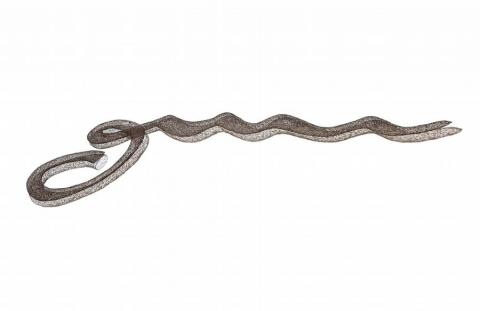INSIGNIA, 2003
Bronwyn Oliver
copper
291.0 cm length
Christine Abrahams Gallery, Melbourne
Private collection, Sydney
'I think about sculpture as a kind of physical poetry, and I construct my sculpture like constructing sentences, in the sense that I try to exclude associations that are clouding the centre and leave in only associations that add meaning to the core.'1
As one of the country's leading and most celebrated sculptors, Bronwyn Oliver has left behind an important legacy. An intelligence and sophistication informs her practice resulting in mesmerising, elegant and stunningly beautiful works of art.
The interplay of tension between depth, surface, air and light is delicately balanced in her work. Her sculptures appear caged and resilient yet exposed and vulnerable all at the same time, existing in a fragile realm that is subversively robust and unyielding. Like veins in a leaf, an intricate system of copper is woven together to form an impeccable whole. Oliver was able to successfully tame this seemingly immutable medium, melding and stylising it to form a unique sculptural lexicon.
Oliver's sculptures appear as inanimate objects, yet seemingly coil and recoil upon further inspection - at once immobile and inert, yet also active and dynamic. This duality of energy and still sense of calm within the work brings with it an elevated level of artistic achievement.
The curly copper form of Insignia 2003 alludes to a serpent in motion or a gnarled twisted twig, and as the title suggests, serves as an exemplary symbol of Oliver's talent. Like the articulation of a melody in physical form, Insignia acts as a ripple of energy, a direct expression embodied through a painstaking and laborious technique.
Insignia holds resonance with earlier works such as Curlicue 1991 and later horizontal copper works such as Warp 2006. Specifically with the curved twisted coil and hollow raised end that acts as an opening to a passageway. Insignia acts as a cavity to be explored. The formation of this structure is based upon principles of spiralling and stretching. The repetition of pattern and textural dexterity of this ambitious work play on ideas of growth and renewal.
Oliver's awe-inspiring works embody a sense of elegance and refinement that is unmatched and exclusively hers.
1. The artist cited in Fenner, F., 'Introductory Essay', Bronwyn Oliver, Moet et Chandon, Epernay, France, 1995.
